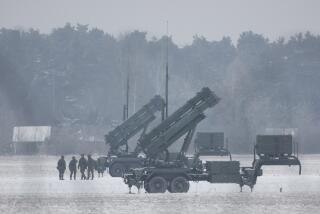Stealth Bomber Cost Estimate Hits $70 Billion
- Share via
The B-2 stealth bomber program will cost an estimated $70 billion, deputy defense secretary Donald Atwood said in congressional testimony Thursday, indicating that the program has increased in cost by about $2 billion since last year.
The long-awaited official revision of the B-2 cost resulted from a review of the program by the Defense Acquisition Board, a high-level Pentagon panel that controls major weapons programs.
Defense Secretary Dick Cheney ordered the review last month after he complained that he was getting conflicting cost figures on the B-2, which is produced by Northrop.
The B-2 cost, which amounts to $530 million per aircraft if all the program costs are included, has fueled an increasing controversy.
House Armed Services Committee Chairman Les Aspin has been critical of the risk that the Air Force is taking on the bomber program. Aspin had estimated in May that it will cost $75 billion, based on unclassified calculations.
The Air Force said last year that the bomber program would cost $68.1 billion. The growth to $70 billion apparently was caused, at least in part, by a one-year delay in full-scale production ordered this year by Cheney.
Cheney ordered the delay after he expressed concern about technical problems and a shortage of defense funds. But after a recent visit to Northrop’s Palmdale plant, he said he was “tremendously impressed” by the bomber.
Of the $70-billion program cost, about $15 billion has already been spent on research, development and low-rate production. The $55-billion balance includes the aircraft and various associated costs, such as construction of special facilities.
The B-2 is designed to elude enemy radar by using a variety of new technologies and to drop up to 25 tons of nuclear or conventional bombs on enemy targets. The aircraft is known as a “flying wing” because it lacks a conventional fuselage and tail assembly.
Air Force Gen. Bernard P. Randolf said in a recent speech that the unusual design has been tested in wind tunnels for 24,000 hours and will be stable in flight, despite some criticism from experts who have questioned whether the B-2 will be airworthy.
The maiden flight of the first B-2, which is about a year and a half behind the original schedule, is expected to occur within a few weeks at Edwards Air Force Base near Lancaster. The flight will not be announced before takeoff, but the Air Force has vowed to report it about four hours later.
In a breakfast meeting with reporters last Friday, Air Force Secretary Donald B. Rice said the fate of the B-2 program rests on how it performs in its flight-test program. He told reporters that the Defense Acquisition Board had recently recommended building the aircraft, an important milestone.
Northrop officials said they do not know what assumptions about the pace of production, future inflation and the quantity of aircraft to be built were used to calculate the $70-billion figure.
Northrop has said the so-called average unit fly-away cost of the B-2 is $265 million in current dollars, based on the original assumptions about the pace of production and quality of aircraft.
“The number of hours to build the aircraft hasn’t changed,” said Northrop senior vice president Les Daly. Asked how many hours it would take to build one, he said the figure is classified.
Daly emphasized that Northrop’s estimate of $265 million per aircraft is not at odds with the Pentagon’s estimate of $550 million per plane.
The Pentagon’s new estimate of the B-2 program cost is based on the $15 billion spent so far and future production costs, including expected inflation.
More to Read
Inside the business of entertainment
The Wide Shot brings you news, analysis and insights on everything from streaming wars to production — and what it all means for the future.
You may occasionally receive promotional content from the Los Angeles Times.











